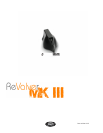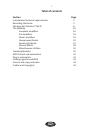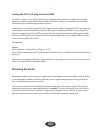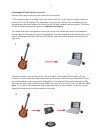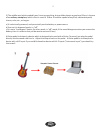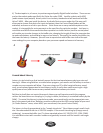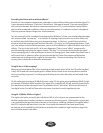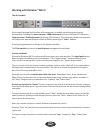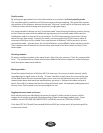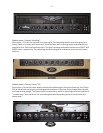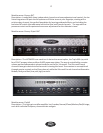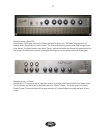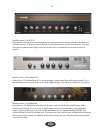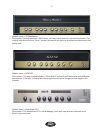
4) The best opon is, of course, to purchase a good quality Digital Audio Interface. There are sev-
eral on the market made specically for Guitar for under $100. Look for a device with ASIO
(audio stream input/output) drivers, which is an industry standard and will work well with Re-
Valver® MKIII. Aer you install the device, the Audio Devices menu under the File menu will
allow you to choose that device for input and output, then the Control Panel buon will be
acvated, and serve as a link to your device. Since there are so many available opons on the
market, it is impossible for us to comment on the specics of a parcular product. Just keep in
mind that most ASIO-driven audio interfaces operate in a similar fashion, and the control panel
will enable you to make changes to the buer size, changing the length of me the computer has
to make calculaons, and resulng in more or less latency. Generally, the smaller the buer size,
the lower the latency. However, you will have to experiment with buer sizes to nd the op-
mum sengs for your computer, based on your processor speed and amount of memory.
Awordaboutlatency
Latency is a technical term that basically means for the me lapse between playing a note and
hearing it. When using ReValver as a stand alone program, you need to set the latency to as low a
number as your computer will allow. If you are using your PC or Mac’s original factory sound
card, you are almost guaranteed to have latency issues. It really does make sense to get a high-
quality sound card, and there are many models available at various price levels.
ReValver by itself does not control how much latency you will experience with the program,
neither the stand-alone nor the plug-in. (In plug-in mode, the latency is controlled enrely by the
DAW). To control the latency in stand-alone mode, you are advised to set the appropriate num-
bers in the sound card driver. ReValver provides a shortcut to the ASIO control panel of your card.
(In “Audio Devices” menu, select ASIO, your sound card, then press Control Panel).
The latency is directly proporonal to the “sample chunk size.” Short latency equals small chunk
size. Recommended chunk size is 128-256 samples. If the sound is breaking up (choppy sound,
stuering), increase the buer size. (Try these standard values: 64, 128, 256, 512, 1024, 2048).
It is advisable to start with a smaller number and gradually increase unl the sound is no longer
choppy.
6



